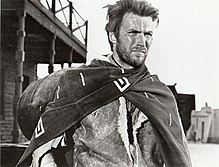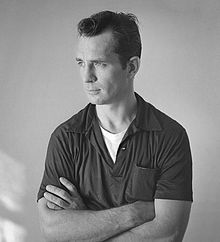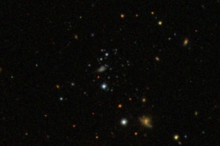안티히어로
Antihero
안티히어로(antihero)[1] 또는 안티히어로(antiheroine)는 이상주의, 용기, 도덕과 같은 전통적인 영웅적 특성과 속성이 부족할 수 있는 서사(문학, 영화, TV 등)의 주인공입니다.[1] 안티히어로는 때때로 대부분의 청중이 도덕적으로 옳다고 생각하는 행동을 수행할 수 있지만, 그렇게 하는 이유는 청중의 도덕과 일치하지 않을 수 있습니다.[2]
안티히어로는 전통적인 영웅, 즉 사회적 지위가 높은 영웅과 대척점에 서 있는 것으로 이해할 수 있는 문학 용어입니다. 표면적으로 학자들은 안티히어로에 대한 추가 요구 사항을 가지고 있습니다. 몇몇 학자들은 여러 요인에 의해 정의되는 "라키니안" 안티히어로를 언급합니다. 첫 번째는 안티히어로가 모험이 시작되기 전에 실패할 운명이라는 것입니다. 두 번째는 그 실패의 책임이 자신을 제외한 모든 사람에게 있습니다. 셋째, 사회적 도덕과 현실에 대한 비판을 제공합니다.[3] 다른 학자들에게 안티히어로는 본질적으로 특정 관점의 영웅이고 다른 관점의 악당입니다.[4] 이 아이디어는 롤플레잉 게임에서 일반적으로 표시되는 캐릭터 정렬을 추가하여 더욱 뒷받침됩니다.[5]
대표적으로 안티히어로는 주인공으로서든 적대적인 힘으로서든 이야기에서 갈등의 초점입니다.[6] 이는 더 큰 이익을 위해 봉사하라는 구체적인 소명이 아니라 보통 자신의 의지로 전쟁에 참여한 안티히어로 때문입니다. 이와 같이, 안티히어로는 무엇보다도 그들의 개인적인 동기에 초점을 맞추고, 다른 모든 것은 부차적입니다.[7]
역사

초기의 반영웅은 호메로스의 테르시테스입니다.[8] 이 개념은 고전 그리스 드라마,[9] 로마 풍자, 그리고 돈키호테와[9][10] 피카레스크 악당과 같은 르네상스 문학에서도[8] 확인되었습니다.[11]
안티히어로라는 용어는 일찍이 1714년에 처음 사용되었고,[12] 18세기에 Rameau의 조카와 같은 작품에서 등장했으며,[8] 영국 시인 Lord Byron이 만든 바이로닉 영웅을 다루는 데에도 더 광범위하게 사용됩니다.[13]
19세기의 문학적 낭만주의는 고딕 더블과 [14][15]같은 새로운 형태의 안티히어로를 대중화하는 데 도움을 주었습니다.[16] 안티히어로는 결국 사회적 비판의 확립된 형태가 되었는데, 이 현상은 표도르 도스토예프스키의 '지하에서 온 노트'에 등장하는 이름 없는 주인공과 종종 연관되어 있습니다.[8] 안티히어로는 전통적인 영웅 원형에 대한 호일로 등장했는데, 이 과정은 노스럽 프라이가 가상의 "중력의 중심"이라고 불렀던 과정입니다.[17] 이 운동은 영웅적 기풍이 봉건 귀족에서 도시 민주주의자로 문학적 변화를 나타냈고 서사극에서 아이러니한 서사극으로의 변화를 나타냈습니다.[17]
허클베리 핀(1884)은 "미국 보육원의 첫 번째 안티히어로"라고 불립니다.[18] 서머빌의 샬롯 뮬렌과 로스의 리얼 샬롯(1894)은 안티헤로인으로 묘사되었습니다.[19][20][21]
이 반영웅은 프란츠 카프카의 변태 (1915),[22] 장 폴 사르트르의 메스꺼움 (1938),[23] 알베르트 카뮈의 이방인 (1942)과 같은 실존주의 작품에서 두드러졌습니다.[24] 이 작품들에서 주인공은 인생을 표류하는 우유부단한 중심 인물로 지루함과 불안, 소외감이 특징입니다.[25]
1950년대와 1960년대 중반까지 의사소통이 불가능한 소외된 인물로 미국 문학에 입문한 안티히어로.[26] 1950년대와 1960년대의 미국의 반영웅은 전형적으로 프랑스의 반영웅보다 더 적극적이었습니다.[27] 영국판 안티히어로는 1950년대의 "분노한 젊은이들"의 작품에서 등장했습니다.[9][28] 60년대 반문화의 집단 시위는 문학적, 영화적 형태의 부활이 없는 것은 아니지만 고독한 안티히어로가 허구적 명성에서 점차 가려지는 것을 보았습니다.[27][26]
2000년대부터 현재까지 텔레비전 황금기 동안 토니 소프라노, 그레고리 하우스, 월터 화이트, 돈 드레이퍼, 마티 버드, 너키 톰슨, 잭스 텔러와 같은 반영웅들은 가장 인기 있고 비평가들의 호평을 받은 TV 쇼에서 두각을 나타냈습니다.[29][30][31]
참고 항목
참고문헌
- ^ a b "Anti-Hero". Lexico. Oxford University Press. Archived from the original on 6 August 2020. Retrieved 26 September 2020.
- ^ Laham, Nicholas (2009). Currents of Comedy on the American Screen: How Film and Television Deliver Different Laughs for Changing Times. Jefferson, North Carolina: McFarland & Co. p. 51. ISBN 9780786442645.
- ^ Kennedy, Theresa Varney (2014). "'No Exit' in Racine's Phèdre: The Making of the Anti-Hero". The French Review. 88 (1): 165–178. doi:10.1353/tfr.2014.0114. ISSN 2329-7131. S2CID 256361158.
- ^ Klapp, Orrin E. (September 1948). "The Creation of Popular Heroes". American Journal of Sociology. 54 (2): 135–141. doi:10.1086/220292. ISSN 0002-9602. S2CID 143440315.
- ^ Waskul, Dennis; Lust, Matt (August 2004). "Role-Playing and Playing Roles: The Person, Player, and Persona in Fantasy Role-Playing". Symbolic Interaction. 27 (3): 333–356. doi:10.1525/si.2004.27.3.333. ISSN 0195-6086.
- ^ Petersen, Michael Bang (2019). "An Age of Chaos?". RSA Journal. 165 (3 (5579)): 44–47. ISSN 0958-0433. JSTOR 26907483.
- ^ Klapp, Orrin E. (1948). "The Creation of Popular Heroes". American Journal of Sociology. 54 (2): 135–141. doi:10.1086/220292. ISSN 0002-9602. JSTOR 2771362. S2CID 143440315.
- ^ a b c d Steiner, George (2013). Tolstoy Or Dostoevsky: An Essay in the Old Criticism. New York: Open Road. pp. 197–207. ISBN 9781480411913.
- ^ a b c "antihero". Encyclopædia Britannica. 14 February 2013. Retrieved 9 August 2014.
- ^ Wheeler, L. Lip. "Literary Terms and Definitions A". Dr. Wheeler's Website. Carson-Newman University. Retrieved 3 October 2013.
- ^ Halliwell, Martin (2007). American Culture in the 1950s. Edinburgh: Edinburgh University Press. p. 60. ISBN 9780748618859.
- ^ "Antihero". Merriam-Webster Dictionary. 31 August 2012. Retrieved 3 October 2013.
- ^ Wheeler, L. Lip. "Literary Terms and Definitions B". Dr. Wheeler's Website. Carson-Newman University. Retrieved 6 September 2014.
- ^ Alsen, Eberhard (2014). The New Romanticism: A Collection of Critical Essays. Hoboken: Taylor & Francis. p. 72. ISBN 9781317776000. Retrieved 20 April 2015 – via Google Books.
- ^ Simmons, David (2008). The Anti-Hero in the American Novel: From Joseph Heller to Kurt Vonnegut (1st ed.). New York: Palgrave Macmillan. p. 5. ISBN 9780230612525. Retrieved 20 April 2015 – via Google Books.
- ^ Lutz, Deborah (2006). The Dangerous Lover: Gothic Villains, Byronism, and the Nineteenth-century Seduction Narrative. Columbus: Ohio State University Press. p. 82. ISBN 9780814210345. Retrieved 20 April 2015 – via Google Books.
- ^ a b Frye, Northrop (2002). Anatomy of Criticism. London: Penguin. p. 34. ISBN 9780141187099.
- ^ Hearn, Michael Patrick (2001). The Annotated Huckleberry Finn: Adventures of Huckleberry Finn (Tom Sawyer's Comrade) (1st ed.). New York: W. W. Norton & Company. p. xvci. ISBN 0393020398.
- ^ Ehnenn, Jill R. (2008). Women's Literary Collaboration, Queerness, and Late-Victorian Culture. Ashgate Publishing. p. 159. ISBN 9780754652946. Retrieved 7 April 2020 – via Google Books.
- ^ Cooke, Rachel (27 February 2011). "The 10 best Neglected literary classics – in pictures". The Guardian. Retrieved 7 April 2020.
- ^ Woodcock, George (1 April 1983). Twentieth Century Fiction. Macmillan Publishers Ltd. p. 628. ISBN 9781349170661. Retrieved 7 April 2020 – via Google Books.
- ^ Barnhart, Joe E. (2005). Dostoevsky's Polyphonic Talent. Lanham: University Press of America. p. 151. ISBN 9780761830979.
- ^ Asong, Linus T. (2012). Psychological Constructs and the Craft of African Fiction of Yesteryears: Six Studies. Mankon: Langaa Research & Publishing CIG. p. 76. ISBN 9789956727667 – via Google Books.
- ^ Gargett, Graham (2004). Heroism and Passion in Literature: Studies in Honour of Moya Longstaffe. Amsterdam: Rodopi. p. 198. ISBN 9789042016927 – via Google Books.
- ^ Brereton, Geoffery (1968). A Short History of French Literature. Penguin Books. pp. 254–255.
- ^ a b Hardt, Michael; Weeks, Kathi (2000). The Jameson Reader (Reprint ed.). Oxford, UK ; Malden, Massachusetts: Blackwell. pp. 294–295. ISBN 9780631202707.
- ^ a b Edelstein, Alan (1996). Everybody is Sitting on the Curb: How and why America's Heroes Disappeared. Westport, Connecticut: Praeger. pp. 1, 18. ISBN 9780275953645.
- ^ Ousby, Ian (1996). The Cambridge Paperback Guide to Literature in English. New York: Cambridge University Press. p. 27. ISBN 9780521436274.
- ^ Reese, Hope (11 July 2013). "Why Is the Golden Age of TV So Dark?". The Atlantic. Retrieved 31 October 2021.
A new book explains the link between the rise of antihero protaganists and the unprecedented abundance of great TV (and what Dick Cheney has to do with it).
- ^ Faithful, E. (2021). 하우스 씨가 어떻게 "성대적인 반 영웅"을 주류로 끌어들이고 TV 드라마를 변화시켰는지. www.nine.com.au https://www.nine.com.au/entertainment/latest/house-savant-anti-hero-medical-drama-9now/0e030210-8bfe-424f-b687-f2e36e6f0694
- ^ Pruner, A. (n.d.). 들어보세요. 그레고리 하우스는 TV의 마지막 위대한 의사였습니다. https://editorial.rottentomatoes.com/article/hear-us-out-gregory-house-was-tvs-last-great-doctor/

